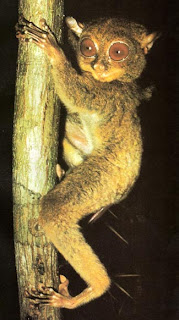
 The tarsier is an extraordinary animal. Relative to weight, the tarsier has the largest eyes of all the mammals.
The tarsier is an extraordinary animal. Relative to weight, the tarsier has the largest eyes of all the mammals.Fossil relatives of the tarsier have been found in Europe, North America and Africa. Now, they live only on some of the islands of Southeast Asia - the south of the Philippines, Borneo, Sumatra and some of the other Indonesian islands. They have not survived well in captivity or as pets.
The tarsiers, unlike any other primates, completely refuse to eat any plant matter whatsoever. They eat mostly insects but sometimes enjoy birds, crabs, snakes, bats, etc, as long as it is something they can grab and eat its little head, crickets and grasshoppers for example. They may be eaten themselves by snakes, lizards, owls, and other birds of prey. Being nocturnal helps them avoid some predators in the dark night. If a tarsier is attacked by a predator, all of the tarsiers nearby may swarm and attack the predator
Tarsiers do like to sing with a high-pitch voice and in some species the males and females perform duets together. Different species of tarsier have different songs and singing styles and that is one way scientists can differentiate between the species.
The tarsier's flexible neck allows its head to swivel around 180 degrees to help it scan for prey or predator.
 See those legs? The tarsier is an amazing jumper able to jump more than 40 times it's own body length. The hind legs can be twice the head and body length. They like to jump and cling to trees.
See those legs? The tarsier is an amazing jumper able to jump more than 40 times it's own body length. The hind legs can be twice the head and body length. They like to jump and cling to trees.
The tarsier has such large eyes because it is a nocturnal hunter and the large eyes help maximize the available light.
The tarsier's fur is grey, gold, ochre, sand-colored or a mix of these colors and very soft.
Tarsiers are prosimian primates of the genus Tarsius, a monotypic genus in the family Tarsiidae, which is itself the lone extant family within the infraorder Tarsiiformes. Although the group was once more widespread, all the species living today are found in the islands of Southeast Asia.
Fossils of tarsiers and tarsiiform primates are found in Asia, Europe, and North America, and there are disputed fossils from Africa, but extant tarsiers are restricted to several Southeast Asian islands including the Philippines, Sulawesi, Borneo, and Sumatra. They also have the longest continuous fossil record of any primate genus,[citation needed] and the fossil record indicates that their dentition has not changed much, except in size, in the past 45 million years.


The tarsiers, unlike any other primates, completely refuse to eat any plant matter whatsoever. They eat mostly insects but sometimes enjoy birds, crabs, snakes, bats, etc, as long as it is something they can grab and eat its little head, crickets and grasshoppers for example. They may be eaten themselves by snakes, lizards, owls, and other birds of prey. Being nocturnal helps them avoid some predators in the dark night. If a tarsier is attacked by a predator, all of the tarsiers nearby may swarm and attack the predator
Tarsiers do like to sing with a high-pitch voice and in some species the males and females perform duets together. Different species of tarsier have different songs and singing styles and that is one way scientists can differentiate between the species.
The tarsier's flexible neck allows its head to swivel around 180 degrees to help it scan for prey or predator.
 See those legs? The tarsier is an amazing jumper able to jump more than 40 times it's own body length. The hind legs can be twice the head and body length. They like to jump and cling to trees.
See those legs? The tarsier is an amazing jumper able to jump more than 40 times it's own body length. The hind legs can be twice the head and body length. They like to jump and cling to trees.The tarsier has such large eyes because it is a nocturnal hunter and the large eyes help maximize the available light.
The tarsier's fur is grey, gold, ochre, sand-colored or a mix of these colors and very soft.
Tarsiers are prosimian primates of the genus Tarsius, a monotypic genus in the family Tarsiidae, which is itself the lone extant family within the infraorder Tarsiiformes. Although the group was once more widespread, all the species living today are found in the islands of Southeast Asia.
Fossils of tarsiers and tarsiiform primates are found in Asia, Europe, and North America, and there are disputed fossils from Africa, but extant tarsiers are restricted to several Southeast Asian islands including the Philippines, Sulawesi, Borneo, and Sumatra. They also have the longest continuous fossil record of any primate genus,[citation needed] and the fossil record indicates that their dentition has not changed much, except in size, in the past 45 million years.


